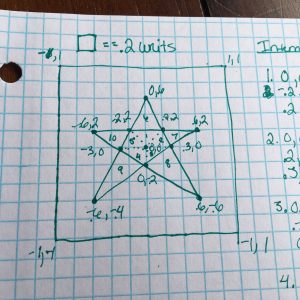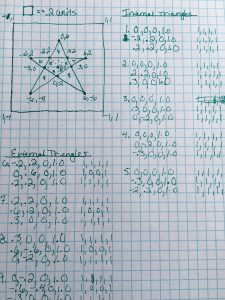Hi.
Today I blocked several people for the first time ever on Twitter. These are people I have known for a long period of time and one of whom I have met in person and know to not be a sociopath. Here is why.
I have Post Traumatic Stress Disorder. When I was in college a stranger held me hostage in my dorm room and raped and tortured me for two and a half hours. For those of you fortunate enough to not have PTSD, one of the delightful aspects of having it is dealing with flashbacks. Flashbacks happen when you are in a situation that is reminiscent in some way of the circumstances that caused your trauma. It’s your brain’s way of protecting you. It senses that you are in a similar situation to one where bad things happened to you, so it tries to force you to flee from that situation to protect yourself.
I recently certified Delia as an Emotional Support Animal because one thing that triggers flashbacks is being trapped in an enclosed metal tube with a bunch of men I don’t know. I can fly without her, but the efforts it takes for me to calm myself down for several hours drains every ounce of energy I have. I get to my destination exhausted and it can take me up to a month to recover.
Another thing that triggers flashbacks is dealing with aggressive males who do not listen to me and continue to engage me when I want to be left alone.
There have been multiple times this year on Twitter where I have made a comment or asked a question and have been bombarded with well meaning but obnoxious advice from men. It ranges from speaking to me like I am a toddler and couldn’t possibly have considered the most obvious solution that they are giving me or trying to force me to use their preferred mode of whatever in spite of my pleas saying that I already considered it and it won’t work for reasons I don’t want to articulate in 20 tweets.
When this happens, I start to feel overwhelmed. I feel personally attacked and unsafe. It causes me tremendous amounts of emotional distress. I start to have flashbacks and experience all the emotions I experienced when I was being raped. I have had at least a half dozen times this past year where I have gotten so distressed from these interactions that I have had to make emergency appointments with my therapist and spend money I don’t have trying to recover to the point that I am able to work. I have been in constant fear of not being able to work and earn money and destroying my career this year because these well meaning but clueless men have insisted upon trying to be “helpful.”
I have tried multiple times over the last year to explain to people that what they are doing is causing me real harm and damage. Every time I have attempted to engage in a dialog in explaining where I am coming from, I get a bunch of defensiveness and people telling me that they’re engineers. They want to solve the problem. They’re not intending to cause me psychological damage and therefore I don’t have the right to be upset by their behavior.
I don’t give a shit what you intend. It’s the result of your actions that matters.
If you are driving around and you get distracted by your phone and run someone over who is paralyzed for life, it doesn’t matter that you didn’t intend to run them over. They’re still damaged. You don’t get to hide behind your intensions when what you are doing is causing me actual harm.
I am tired of being responsible for having to do the emotional legwork that men are unwilling to do. I have told them many times how to avoid causing me harm and I am being told it’s my problem and they won’t change because their desire to avoid hearing that they’re doing something harmful is greater than my need to be able to earn a living.
I don’t want to be a massive bitch and make people feel like they can’t talk to me without getting bitched out, so I am establishing my rules so that I can protect myself psychologically while still being able to engage with people on Twitter:
First Strike: I Ask You to Back Off
I understand that on Twitter things can escalate very quickly and tempers can flare. At this point something will have happened and I will start to feel overwhelmed but I can still avoid a total shutdown, but only if you stop engaging with me.
I will tell you that I am feeling overwhelmed and ask you to back off.
At this point, if you back off, we’re good. You can feel good about being an engineer and know that you have made a situation better. If you still want to make this point to me later, please wait a day. Ask me for my email and send me an email or give me a chance to engage in a better forum of communication.
Second Strike: I Send You a Link to this Blog Post
It’s possible you’re reading this because I sent you a link to this blog post. I am trying to explain to you why I can’t continue to engage with you. I am not trying to blame you or tell you that you’re an asshole. I am assuming that you mean well and I am trying to find some way to let you know that was you are doing is causing me harm with the hope that you will respect my need to be left alone. Again, if you read this post and you back off and leave me alone, no harm, no foul.
Third Strike: I Will Block You
If you have gotten to this point and you are still continuing to engage with me, then I will block you. I am doing this out of emotional self defense. You have shown that you are not willing to respect my need to feel safe. You are leaving me no other option than to block you to protect myself.
If you’re someone that I know personally and have invested in a relationship with, I will try to remember to unblock you later. I will emphatically ask you to please stop doing things that cause me psychological trauma.
I do not want to block people, but I also do not want to spend a hundred dollars seeing a therapist to be able to keep working. My need to be able to work supersedes your desire to feel helpful. If you want to be helpful, please back off if I tell you that you are forcing me to shut down. If you respect that, we’re cool.
Thank you.


